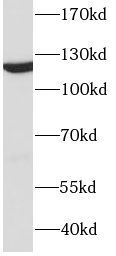Products
DDB1 antibody
| Synonyms: | DNA damage-binding protein 1|DDB p127 subunit|DNA damage-binding protein a (DDBa)|Damage-specific DNA-binding protein 1|HBV X-associated protein 1 (XAP-1)|UV-damaged DNA-binding factor|UV-damaged DNA-binding protein 1 (UV-DDB 1)|XPE-binding factor (XPE-BF)|Xeroderma pigmentosum group E-complementing protein (XPCe)|DDB1|XAP1 antibody | ||
| Catalogue No.: | FNab02285 | Reactivity: | Human, Mouse, Rat |
| Host: | Mouse | Tested Application: | ELISA, WB, IHC, IF |
| Clonality: | monoclonal | Isotype: | IgG2a |
| Size | Price |
|---|---|
| 100µg | Inquiry |
- SPECIFICATIONS
- FIGURES
- CONDITIONS
- FAQS
- Product Name
- DDB1 antibody
- Catalogue No.
- FNab02285
- Size
- 100μg
- Form
- liquid
- Purification
- Protein A+G purification
- Purity
- ≥95% as determined by SDS-PAGE
- Clonality
- monoclonal
- Isotype
- IgG2a
- Clone ID
- 3A0
- Storage
- PBS with 0.02% sodium azide and 50% glycerol pH 7.3, -20℃ for 12 months(Avoid repeated freeze / thaw cycles.)
- Immunogen
- damage-specific DNA binding protein 1, 127kDa
- Alternative Names
- DNA damage-binding protein 1|DDB p127 subunit|DNA damage-binding protein a (DDBa)|Damage-specific DNA-binding protein 1|HBV X-associated protein 1 (XAP-1)|UV-damaged DNA-binding factor|UV-damaged DNA-binding protein 1 (UV-DDB 1)|XPE-binding factor (XPE-BF)|Xeroderma pigmentosum group E-complementing protein (XPCe)|DDB1|XAP1 antibody
- UniProt ID
- Q16531
- Observed MW
- 127 kDa
- Tested Applications
- ELISA, WB, IHC, IF
- Recommended dilution
- WB: 1:500-1:2000; IHC: 1:200-1:800
 HeLa cells were subjected to SDS PAGE followed by western blot with FNab02285(DDB1 antibody) at dilution of 1:1000
HeLa cells were subjected to SDS PAGE followed by western blot with FNab02285(DDB1 antibody) at dilution of 1:1000
 Immunohistochemistry of paraffin-embedded human cervical cancer using FNab02285(DDB1 antibody) at dilution of 1:200
Immunohistochemistry of paraffin-embedded human cervical cancer using FNab02285(DDB1 antibody) at dilution of 1:200
- Background
- Required for DNA repair. Binds to DDB2 to form the UV-damaged DNA-binding protein complex(the UV-DDB complex). The UV-DDB complex may recognize UV-induced DNA damage and recruit proteins of the nucleotide excision repair pathway(the NER pathway) to initiate DNA repair. The UV-DDB complex preferentially binds to cyclobutane pyrimidine dimers(CPD), 6-4 photoproducts(6-4 PP), apurinic sites and short mismatches. Also appears to function as a component of numerous distinct DCX(DDB1-CUL4-X-box) E3 ubiquitin-protein ligase complexes which mediate the ubiquitination and subsequent proteasomal degradation of target proteins. The functional specificity of the DCX E3 ubiquitin-protein ligase complex is determined by the variable substrate recognition component recruited by DDB1. DCX(DDB2)(also known as DDB1-CUL4-ROC1, CUL4-DDB-ROC1 and CUL4-DDB-RBX1) may ubiquitinate histone H2A, histone H3 and histone H4 at sites of UV-induced DNA damage. The ubiquitination of histones may facilitate their removal from the nucleosome and promote subsequent DNA repair. DCX(DDB2) also ubiquitinates XPC, which may enhance DNA-binding by XPC and promote NER. DCX(DTL) plays a role in PCNA-dependent polyubiquitination of CDT1 and MDM2-dependent ubiquitination of TP53 in response to radiation-induced DNA damage and during DNA replication. DCX(ERCC8)(the CSA complex) plays a role in transcription-coupled repair(TCR). May also play a role in ubiquitination of CDKN1B/p27kip when associated with CUL4 and SKP2.
How many times can antibodies be recycled?
First, usually it's not suggested to recycle antibodies. After use, buffer system of antibodies has changed. The storage condition of recycled antibodies for different customers also varies. Thus, the performance efficiency of recycled antibodies can’t be guaranteed. Besides, FineTest ever conducted the antibody recycling assay. Assay results show recycling times of different antibodies also varies. Usually, higher antibody titer allows more repeated use. Customers can determine based on experimental requirements.
Notes: After incubation, we recycle rest antibodies to centrifuge tube and store at 4℃. High titer antibodies can be stored for a minimum of one week. Reuse about three times.
What are components of FineTest antibody buffer?
Components of FineTest antibody buffer are usually PBS with proclin300 or sodium azide, BSA, 50% glycerol. Common preservative is proclin300 or sodium azide, which is widely applied in the lab and industry.
How about the storage temperature and duration of FineTest antibodies?
Most antibodies are stored at -20℃. Directly-labeled flow cytometry antibodies should be stored at 2 - 8℃. The shelf life is one year. If after sales issues for purchased antibodies appear, return or replacement is available. Usually, antibodies can be still used after the one-year warranty. We can offer technical support services.
Is dilution required for FineTest antibodies? What’s the dilute solution?
Directly-labeled flow cytometry antibodies are ready-to-use without dilution. Other antibodies are usually concentrated. Follow the dilution ratio suggested in the manual. Dilute solution for different experiments also varies. Common antibody dilution buffers are acceptable(e.g. PBST, TBST, antibody blocking buffer).
How to retrieve antibodies for immunohistochemistry?
Common retrieval buffers: Tris-EDTA Buffer(pH 9.0); Citrate Buffer(pH 6.0)
Heat induced antibody retrieval:
Method 1: Water-bath heating: Put the beaker with retrieval buffer and slide in the boiling water bath. Keep the boiling state for 15min. Naturally cool to room temperature;
Method 2: Microwave retrieval: Put the beaker with retrieval buffer and slide in the microwave oven. Heat at high power for 5min, Switch OFF for 3min, Heat at medium power for 5min. Naturally cool to room temperature.
How to choose secondary antibodies?
(1) Secondary antibodies react with primary antibodies. Thus, secondary antibodies should be against host species of primary antibodies. E.g. If the primary antibody is derived from rabbit, the relevant secondary antibody should be against rabbit. E.g. goat anti rabbit or donkey anti rabbit.
(2) Choose secondary antibody conjugates according to the experimental type, e.g. ELISA, WB, IHC etc. Common enzyme conjugated secondary antibodies are labelled by HRP, AP etc. Fluorescin or dye labelled secondary antibodies are applied in immunofluorescence and flow cytometry(e.g. FITC, Cy3).
